6 Battalion Royal Australian Regiment (6 Bn RAR/NZ (ANZAC) arrived in South Vietnam in May 1969 and five days later 5 Platoon was tasked with a platoon standing patrol around 3 kilometres from the base.
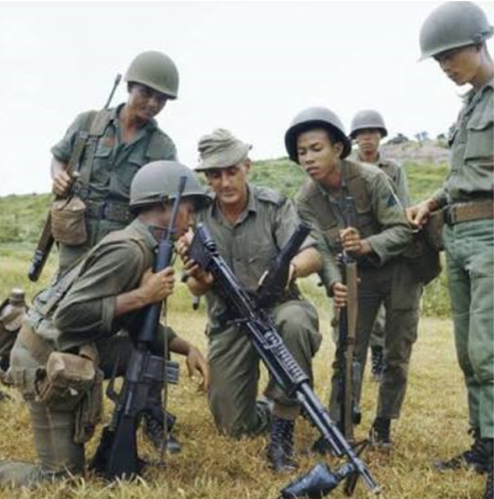
The area was like a football field with no cover at all. Around 1700hrs a 105mm shell landed in the centre of the platoon. We reckoned ‘Charlie’ was on to us, then it came over the radio, “Sorry, the NZ gunners had mucked up”. No one was hurt but we were all pretty stunned.
Then at first light the base was hit by 122mm rockets. We observed the direction of the launch and requested 105mm artillery support but as the base had been hit all support was then controlled by the Brigade Commander.
Over the next 12 months our platoon copped two more 105mm rounds, a batch of 81mm mortars and to top it off, 155mm US Guns as we had moved into a Haress and indiction area.
We then had orders to move and RV with the tanks and APCs. The move was to take us to the village of XA Binh Ba, meeting up with the rest of the Bn. After a short while the plans were changed and 5 RAR got the task – ‘lucky them’, as they had a bloody great hard battle.
For the record 5 RAR did a house and village search of XA Binh Ba (50 by 700 metres) back in August 1966. I have a piece of very sharp shrapnel to this day in my collection.
Twice during my tour, my section did a standing patrol (TAOR) at this site in the rubber trees of Long Tan, 4km from the base, with a river to cross. I only had seven men in my section so all eyes were open for the whole 24 hours. Note lots of old equipment laying around after the Battle of Long Tan.
We carried plenty of ammo, 1100 rounds for each GPMG. I had 21 magazines for my M16 as well as Defencive Fire on call. We operated with only two sections at times thus I had the two GPMGS. They are a lethal weapon. Gee I love these guns (GPMG M60) they kill more than any rifles do.
The poor Army of the Republic of Viet Nam (ARVN) platoons only had one GPMG in the whole bloody platoon so were severely outgunned by the North Vietnamese Army (NVA).
Why so much ammo? I remember the Tunnel Rats section lost three men while on a night standing patrol forward of Fire Support Base Anderson near Bien Hoe.
We gained a skull from this location which was placed above our company’s Diggers Bar and had red lights flashing in the eyes and an NVA helmet on top. Dick Kluczniak, a former 2 Cdo Coy man who was then with the SAS, came to have a beer with me and could not drink at the bar, as it made him sick and we had to drink outside. I passed this story on to Gen Campbell at the Commando Dinner last year as he was doing away with death head badges and similar as used by the Defence Force. He was shocked that this occurred. Times have changed!
B Coy 6 RAR had a major battle in the first three weeks we were in the country. 5 Platoon earned a Military Cross for our Platoon Commander – not bad for the first 21 days in-country. During the battle the OC Maj Dutchy Holland, ex-SAS, came forward to ask about the snipers shooting at us. The Pl Commander and I directed him and as he placed his arm out to look around the tree he was shot through the arm. Such is life, he was repatriated home in the first month.
Dutchy took over command of the Coy back in Townsville from our great Maj Les Kehoe who had been my Adjt/QM at 2 Commando Company. Les had completed two years with the US SEALs. Les was moved out of 6 RAR by the CO because he was working his Diggers like a Commando Company. Les introduced realistic and imaginative training at considerable risk to his future career. Yes, he was hard but it paid off in Nam – he was a great leader.
Back to B Coy’s battle. The Coy was patrolling in bloody heavy rain with 6 Pl leading. They sprung an NVA sentry hiding under a sheet of plastic. My section came forward for the attack. With 6 Pl we covered this sentry throughout the line up. My 2IC John Joyce was to fire the M72 at the sentry and that was the start of our attack with 6Pl.
The 6Pl Sgt ‘Butts’ Buttery ex-SAS (we both did our Para Stick Commanders Course together at PTF in 1965) told me to drop our packs with his 6Pl group’s gear that was in the open. But I ordered our packs placed away in the bush.
We attacked the large bunker system and they beat us back.The remainder of 5 Pl and my section while waiting to attack again received rounds from across a clearing to our right ( just like being on the Williamstown Rifle Range in the butts but no mantle to help).
We then attacked again with no luck. Moving back in a defence position the NVA snipers held the upper hand. So good was our training that we only had four wounded. The worst was Pte Mick Dunn from Euroa, whose Dad was a doctor there. Mick had the radio and every time he moved the bloody sniper punched a round into him. To get Mick out we got him to drop his gear, with the Platoon firing in the direction of the snipers. Mick had to hold a handful of his guts and run around 40 metres. He had been hit five times. Mick stayed in the army for some years after.
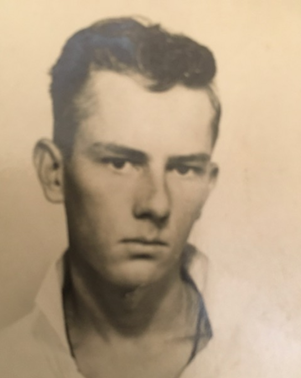
Still under fire the Coy pulled back to an LZ to get the wounded out. My section was on the axis of the withdrawal and we could see Charlie getting lots of 105mm shells (about 1000 rounds) on their area and the bunkers. As darkness came on us we called in spooky C47 with gatling guns which was an eye-opener.
Our Pl Commanders own words, from his web site, “We fought in the jungles of Vietnam in a prolonged engagement with a regular North Vietnamese Army Heavy Machine Gun Company”. He was awarded the Military Cross. It is, he says, a medal he wears on behalf of the diggers who fought so courageously alongside him.
We moved out with a hand on each other’s shoulders to an alteranative night location. Capt. Doug Byers MC was Coy 2IC and had command of the Coy – he did an outstanding job.
At first light we got into it again and found many dead bodies, about ten, to greet us and we had to dig up some as well.
My section’s packs were recovered from their secluded hide, but 6 Platoon’s that had been left exposed were missing. Charlie had taken their packs, all new Aussie packs, and the Pl Commander’s Hong Kong pack. Our 5 Pl had the job to chase down and recover the packs and we did. It took some five days chasing Charley and the only pack not recovered was the 6 Pl boss’s Hong Kong pack. Charley ate the rations and left the rubbish along the way, also cutting off the top flaps with the entrenching tools attached. They set our own Claymores along the way to slow us down and placed cleaning rods in the ground.
I cut two side pouches off one of the packs and used them throughout my career and still have them to this day.
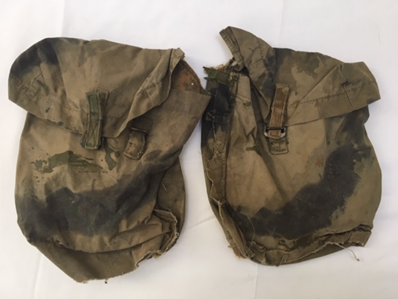
We continued on our way and found a great track well used, setting a section ambush with the other sections and with Pl HQ 100 metres to the rear.
Over the next 5 days we knocked off lots of “bad guys”, with only one wounded, an NVA Major from the Rocket Coy who was shot in the bum. We winched this Major out and spent many more days at this track.
We always worked with seven days supply of rations (three days Aussie – 9 cans of food, and four days US rations – 36 cans of food!) We had to extend our rations and water for another three days which happened a lot during our tour, so the Unit saved lots of ration packs. Food was no problem, but having no water during this period was hard. I was licking the leaves at first light each day. The Coy weakened and we received an airdrop of three water bladders. On landing one bladder ripped on the bamboo and was lost. I think even Charley heard our sighs.
A bit more walking the Jungle then it was back to base. Our first month in-country went well.
I must say I was shocked to think I still had 11 months of this to go, and yes it was just as busy. I could write a book – I almost have.
Maj Mick Harris took over the Coy the next day. He became a great leader. Mick had spent time with the USMC and some of his methods showed through. When our Pl was with the Coy the OC got my section to follow a track for some 3km. We were told to move as fast as we could, the aim being to bump into Charley and then the Coy, like the US Cavalry, would come and help us?
One time after the Coy cleared a bunker system the Coy moved off but left my section in the bloody bunkers – six guys separated over three of the many bunkers – and we were to surprise Charley If he came back, and the Coy would return and help us out.
Mmmm . . No, fortunately Charley did not return.
Captain Doug Byers MC trained Cpl Len Faver and me (we were both ex- 2 Cdo Coy) as part of the 6 RAR cadre (instructor) at JTC back in 1968-69 and worked us bloody hard, which all contributed to the results we gained over the 12 months in SVN.
6 RAR/NZ (ANZAC) Bn was issued with all the latest equipment such as the new Auspacks, the first in SVN.
The Bn killed more NVA in the first month than the Bn we relieved did in the previous 12 months. Enemy KIA 99, 3 KIA by Artillery, 10 taken POW, 22 blood trails identified and Hoi Chanh 1.
We only lost one Digger in the Coy the whole year. Pte Barry James (God Bless) of 4 Pl was lost when his GPMG jammed in an ambush and he was shot in the head. It was not in vain as no GPMGs ever had a stoppage in our Coy during the 11 months after that.
The Coy was awarded 2 MC’s and 1 MM – more could have been awarded. The Military Medal was awarded to Pte Fitzpatrick who years later was the WO Inf at 2 Commando Company.
For the record according to the bestseller book,’ Vietnam’ by Max Hastings, in 1969 the allies in SVN killed the highest number of NVA .
A few months into 1970, near the end of my tour in Vietnam, while on patrol in a creek bed we stopped at a large clearing on our left and we spotted 5 Charleys moving into a small bunch of trees in the centre. I placed the section in line with a GPMG at each end and after contacting Coy asked if there were any troops in our area. “Mouse Trap” – meaning no – was the answer. I then gave the order to engage. When they came out of the trees, we waited for some time so I started to register a Defencive Fire (DF) on the trees, then a chopper came in and the five men hitched a ride. We found out later that they were a New Zealand SAS patrol. Gee, to this day they do not know how lucky they were!
During our first battle above one of our 5 Pl Cpls on his second tour received a small cut on his forehead and was airlifted out with the wounded diggers. A few days later he was sent home with dysentery and after a couple of days in Aussie hospital he was discharged. Because of this my 2IC and great forward scout LCpl John Joyce agreed that we would not leave each other in the weeds unless we finished up WIA or KIA. We had the normal ‘flu and other infections, but two cases I wish to highlight.
John was bitten on the testicular by a scorpion and it swelled up the size of a grapefruit. He had to cut his pants and let it hang out. This lasted several days but he stuck to his forward scout job.
A few months later I had a bad case of dysentery and had to scrape it out of my pants but it got so bad that I cut the backside out of my trousers so I could relieve myself about every 20 or so minutes. This lasted for some days, I cleaned out all the section medical kits of Codeine compound. The best part was a pair of new trousers at the next resupply. At least John and I kept our word to each other.
It was both a sad and good day when John gained his own section in the Platoon. John stayed in the Army and retired as a WO1 (RSM Melbourne University Regt) and has since gone to the parade ground in the sky. (2017)
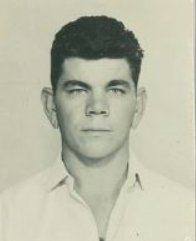
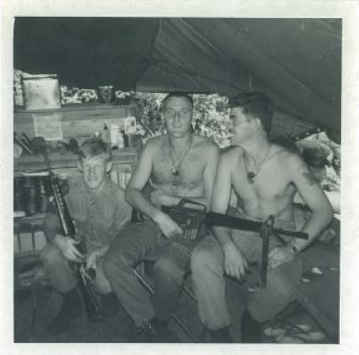
A fine soldier and good friend – John Joyce
Where do I start.
Well, I was a Cpl (CMF) 6 Sect, 5 Pl, B Coy, 6 RAR in Townsville when on a Sunday night at midnight (I was in bed reading) the door flung open and standing there was a Digger with the biggest smile I have ever seen. For the next two hours John explained his life story and said that he had just completed the SASR Cadre ( now Selection) course but was not selected as he was too young.
John became my 2IC in SVN and was also my forward scout through his time with me until he took command of his own Section. I owe so much to John; on many occasions he saved me from trouble, and I will mention a few.
I always carried thirty detonators. They were attracted to painted OD Det Cords of various lengths in my pack – there were no OH&S regulations then. At each night ambush I would set up a mechanical ambush site with possibly 6 Claymores or more mines linked together, with the master detonater and cord attached to a flare taped onto a tree. The trip wire was set at just below waist height.
On October 20 1969 orders arrived at 0400hrs for us to move before first light to an LZ for redeployment to Tan RV Area. I moved out onto the track with John covering me as he always did. In the dark I looked at the wrong tree and moved towards it, when John yelled out with a very loud voice that was non-tactical. I froze. The tripwire was a hand span from my waist!
When we had our turn as 3/43 (ARVN) trainers on the Horseshoe, on arriving at our location I sent John up to clear the 50 calibre machine gun which which was in our bunker as I was settling in the rest of the section. Suddenly “BANG” – one 50 calibre round exploded into the town of Dat Do. During our Shoalwater workup prior to SVN, I had the section trained on the side with 30- and 50-cal by Sgt Rex Harris, an APC Boss. He covered the what’s and wherefore, but John must have been dreaming during the lesson on 50-cal. We all said nothing when he came back down the hill!
When we headed into the Mao Taos mountains (Operation Marsden) on 12 December 1969 our Section was on the last APC of the armoured column. We had stopped, waiting for the bridge layer to do its job. The sun was beating down so I informed the Crew Commander (a very nervous guy who only had four weeks to go in-country) to move the carrier over into the shade off the track, Route 330. We had just moved over when two rounds of mortar landed in the very spot we had just left. Later we found out that they were our own! Friendly fire – the perfect oxymoron!
Anyway, once the rounds landed the Section jumped inside the carrier and closed down – all except me. I had jumped off the side. The carrier took off at a great rate of knots leaving me behind. John in the meantime did a headcount and I was missing. In fact, I was running in the mud after the carrier because I was expecting a hundred VC to come after me, thinking they may be following what we thought were their mortar rounds. Finally the carrier stopped and the personnel door opened revealing John with his big grin, laughing his tits off. What a start to an operation.
A few days later, up the mountain I dropped my pack to do a recon. When I returned, I was explaining what I had seen and as I reached down for my pack, John tackled me and we rolled down the slope. I thought he had gone mad as I pointed my rifle at him. The reason for the attack? A snake had crawled on to my sweat on the pack and coiled itself up. It was a two-step Charlie Krait with a fatal bite. Before Operation Marsden I called into SASR to find out about the mountains and was informed that no SAS Ptl had been luckly enough to venture onto the mountains.
Back in Townsville John and I were walking back from town with a belly full of beer when we heard chooks squawking, and with that we soon had a chook each. Back in our Long Tan lines and into our toilet block we cleaned the little buggers. Next morning John took the fowls to Sgt Cook Reynolds and he placed them in the tray along with his beautiful layout ration chooks. We had a 3-hour job to clean up the toilet block as it looked like we had sloughed D445/VC in there.
John collects our car smash chooks and off we go to Magnetic Island,chooks and beer in hand. Sunday lunch on the beach.
we tried to eat these rubberized chooks – what a waste of time! The fish enjoyed them no doubt, All I can say is, crime does not pay.
So many stories one could fill a book.
Before Vietnam
I was a CMF Sgt on full time duty (FTD) at 2 Commando Coy and was attached to 6 RAR in Townsville for three months. I had the enemy platoon in Shoal Water Bay for the two pre-SVN assessment 1 and 3 Bn exercises, “Grass Parrot and ” Bell Bird”.
After returning to 2 Cdo Coy my last job was to help move the unit from the McWhae Avenue Depot in Ripponlea to Fort Gellibrand, Williamstown over the weekend of 11-12 July 1968.
I was offered an ARA posting as Pl Sgt 9 RAR but requested a posting as Cpl 6RAR. This happened, but I was classified as a CMF Cpl Section Comd (yellow paybook) for six months in the unit with my Diggers earning more pay than me.
There was panic when I was attending the cadre (instructors course) at JTC under Capt Doug Byers MC and I had to go into Recruiting in Brisbane to sign on, as a signal had come through from AHQ to give me Group 6 pay outstanding, with not many Group 6s in the unit.
Why did I drop a rank? Well the above speaks for itself. The “Dirty Half Dozen”, 6RAR, was such a smooth working machine and the 10 NS intake who we did Corp training for in the unit were just great soldiers.
Our B Coy 6 RAR emblem was the Phantom holding a skull which dated from the start of B Coy back in 1965, before my time. A photo shows us fixing up the sign at the entrance to B Coy lines at Nuit Dat with me on the left with some of the boys from 5 Pl.
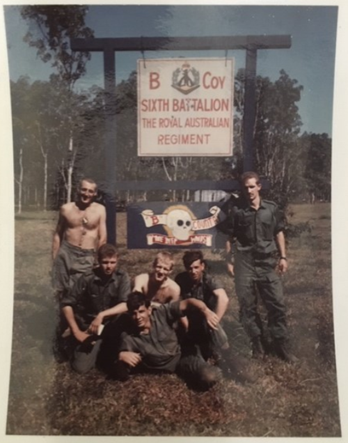
While I am on a roll, when I was a Cpl (FTD) in 1964 back at 2 Commando Coy my boss was WO2 Clem Kealy, a stalwart of the SASR and PTS RSM in later years. Clem presented me with his RAR Badge with the King’s Crown (Edward) and years later when posted to the RAR I always have wore this badge – no plastic ‘Skippy’ for me. Clem did ** three tours with AATTV. In 1999 I contacted Clem and during our many talks, he stated how amazing were the Battalion soldiers ( he also employed RAR Cpls in his group) who worked so hard in SVN. He was so proud; I suppose being an ex-3 RAR during the Korean War he understood.
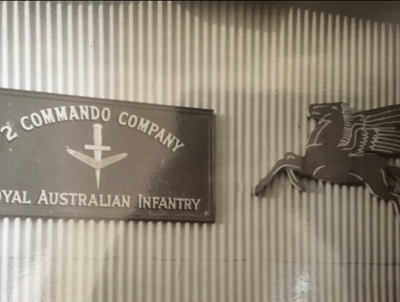
You will notice the photo of the 2 Cdo Coy sign and Pegasus the flying horse at the Ripponlea depot. During my time as a Cpl CMF( FTD) I wrote away to Mobil Oil and requested a sign which they delivered. I painted it with blue hammertone paint then our Adjt/QM Capt Harry Smith (yes, that man!) used his great art skills and painted the outlines. Cpl CMF FTD) Dick Kluczniak and I then installed it on the hanger wall at the McWhae Avenue Depot at Ripponlea.
So many stories one could fill a book.
By David Waterston
( ** Clem Kealy. Australian Army Training Team Vietnam 29 Jul 1964-13 May 1965,
Australian Army Training Team Vietnam 21 Jan 1969-17 Dec 1969,
Australian Army Training Team Vietnam 30 Jan 1970-13 Aug 1970.
From awm website, nominal roll.)
Contact MHHV Friend about this article.






